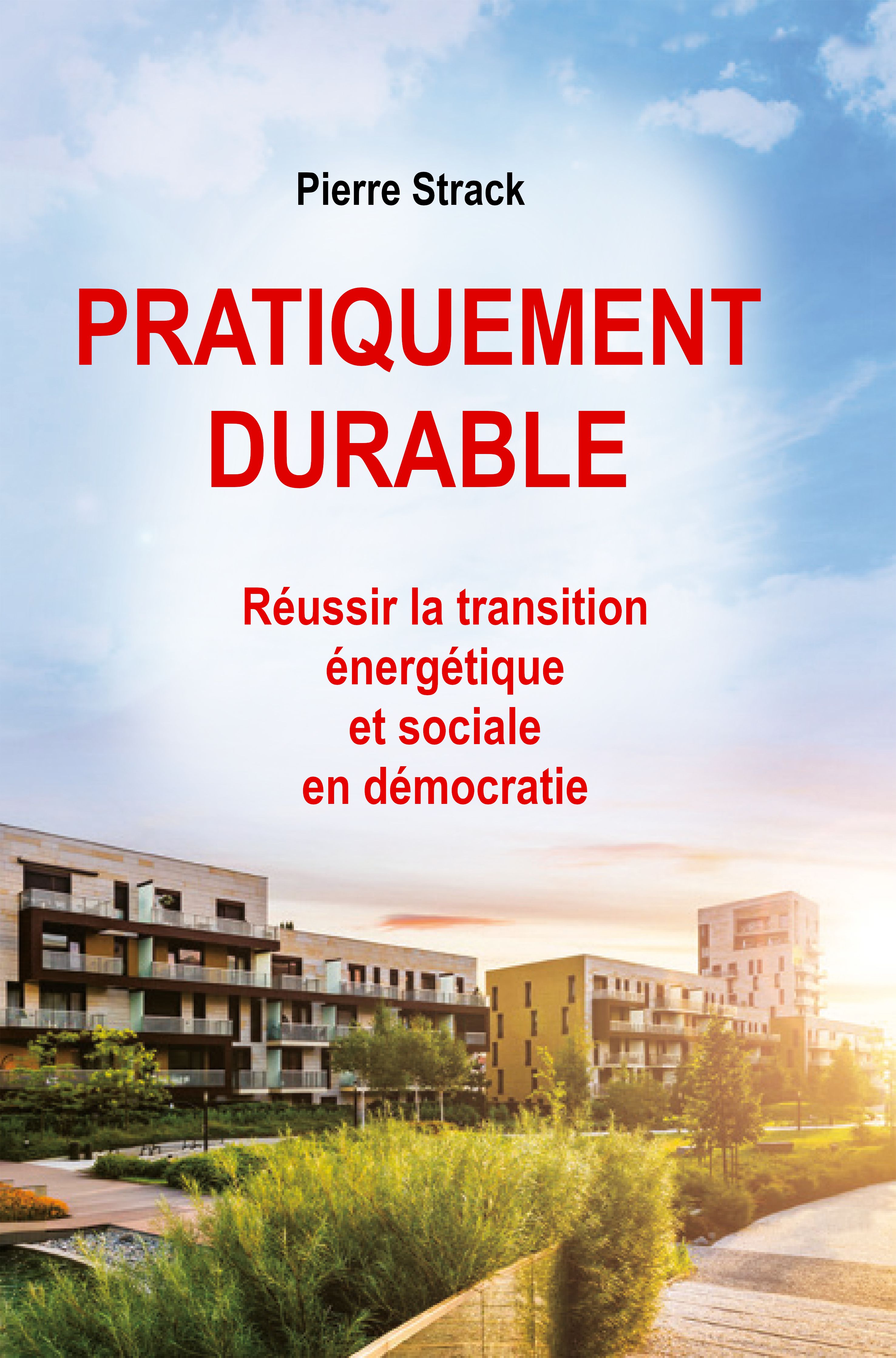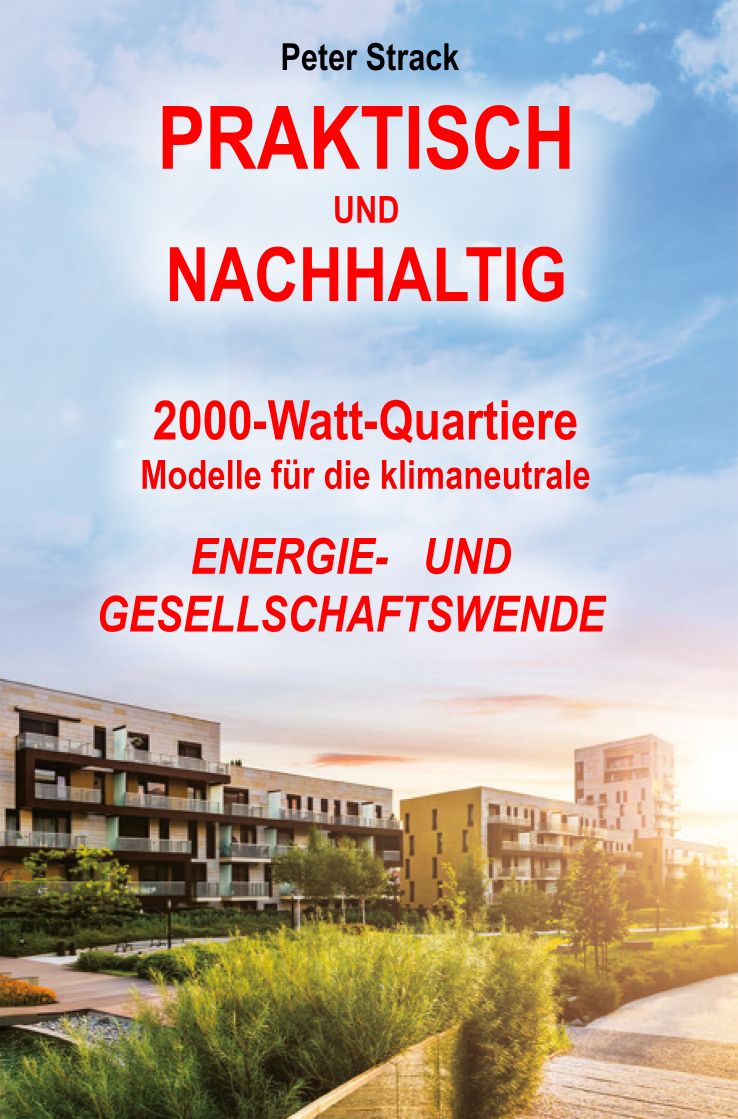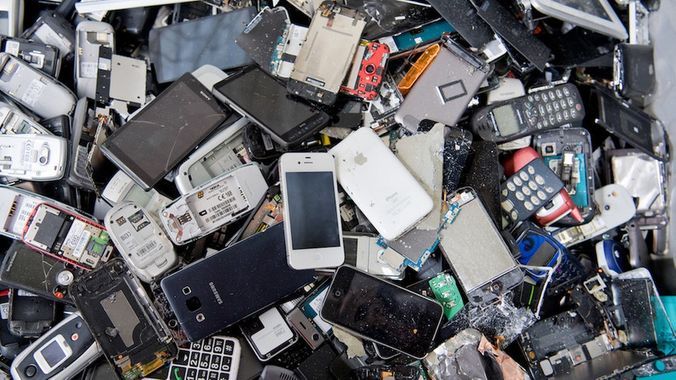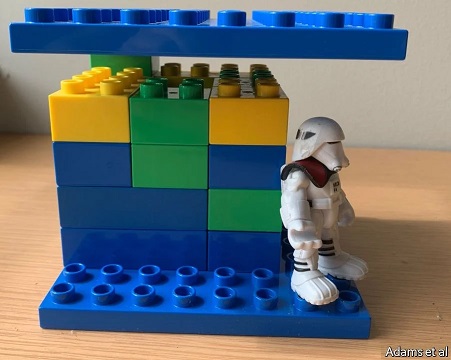Practically sustainable 2000-watt-neighborhoods
Table of content
- Foreword of our MP and Maire
-
 The revised new edition of this french book is available only with Amazon.
The revised new edition of this french book is available only with Amazon. - 1. Introduction
PART I: TECHNICAL PROBLEMS
- 2. Limits of the industrial civilization
- 2.1 Replacing fossil fuels with renewable energies
- 2.2 Relationship between global growth and global energy consumption
- 2.3 Nuclear Energy
- 2.4 Political commitments and reality
- 2.5 Funding, risks and opportunities
- 3. Physical limits of "green growth"
- 3.1 Accepting and living with our planetary limits
PART II: TECHNICAL SOLUTIONS
- 4. 2000-watt neighborhoods
- 4.1 Pursued goals of 2000-watts-neighborhoods
- 4.2 Planning a neighborhood
- 4.3 Social organization of a 2000-watt-neighborhood
- 4.4 Neighborhoods during an epidemic
- 4.5 Implemented techniques
- 4.6 Example of the neighborhood called Kalkbreite
- 4.7 Finances
- 4.8 Theoretical status of 2000-watt-neighborhood in France
- 4.9 Certifications of a 2000-watt-neighborhood
- 4.10 Conclusion about the feasibility
- 5. Sustainable agriculture for post-oil-society
- 5.1 The matrix of urban civilization
- 5.2 The character of Empire
 The german book is available in bookshops and in the internet.
The german book is available in bookshops and in the internet. - 5.3 The productivist agricultural policy of empires
- 5.4 Sustainable agriculture
- 5.5 Contribution of city dwellers to the transformation of agriculture
PART III: HUMAN DIFFICULTIES AND POTENTIALS
- 6. Limits of the materialistic philosophy
- 6.1 Premises of the dominant philosophy
- 7. Freedom for the 2000-watt post-oil-society
- 7.1 Freedom of machinery
- 7.2 Freedom of thought
- 7.3 Freedom of the powerful
- 7.4 Negative freedom
- 7.5 Positive freedom
- 7.6 Sustainable freedom?
- 8. Equality of 2000-watt
- 8.1 Cultural notions of equality
- 8.2 Complex equality allowing diversity
- 8.3 Simple equality of clones
- 8.4 Identities
- 8.5 Equality of energy consumption
- 8.6 Historical development of the concept of Justice
- 9. A sense of community for the post-oil society
- 9.1 Destructive models of Fraternity
- 9.2 Fraternity through semi-direct democracy
- 9.3 Cooperative fraternity
- 9.4 Restorative justice
- 9.5 Fraternity with Creation
- 9.6 Conclusion
- 10. Limiting the power of money over the human mind
- 10.1 Mammon’s Insatiability
- 10.2 Three notions of ownership
- 10.3 When are we satisfied with our wealth?
- 11. Reducing the number of machine-slaves at our service
- 11.1 Very brief history of slavery
- 11.2 Struggles against slavery
- 11.3 Conclusion on machine-slaves
- 12. Conclusion
1. Introduction
Many professionals do important work in countless fields; they multiply very useful knowledge for humanity. This knowledge allows us to create ever more complex societies, at the risk of losing sight of the links between these fields of knowledge. Experts select and write volumes on ever more specialized subjects. In other words, specialists always write more about less. This absurd tendency would lead the best specialists to soon know almost everything about next to nothing.
The downside of specializing in ever narrower disciplines is that the big picture of human society fades away. Often, specialists no longer have a global vision of their own field of competence, let alone of different fields. For this reason, universities see a growing need to create interdisciplinary laboratories, such as the Transdisciplinary Lab at the Swiss Federal Institute of Technology, whose contributions to the 2000-watt neighborhoods will be discussed in this book. Bringing together experts from different disciplines is not easy, as each field uses its own language, which may seem hermetic to the uninitiated.
In the midst of the Covid-19 crisis, Edgar Morin, a French philosopher, said: "How do we have to confront, select and organize all our knowledge adequately by bringing all our knowledge together and integrating uncertainty ? For me, this once again reveals the deficiency of the way we have been taught to acquire knowledge, which makes us disjoint what is inseparable and reduce to a single element what forms a whole, both one and diverse. Indeed, the overwhelming revelation of the upheavals we are undergoing is that whatever seemed separate is connected, since a health crisis extends its catastrophe to all that is human" [1].
Without a general overview, we no longer know how to find our way. Indeed, while some give priority to ecological and climatic problems and accept a reduction of economic output, others see unemployment and poverty and ask for more GDP growth. Some say we need to save energy by creating smaller cars, others say we need to make high-end vehicles which are more profitable, since SUVs sell more easily and generate more profits for the businesses. Some want to reduce car traffic while others increasingly depend on it; which led to the yellow vests revolt in France and accentuated the opposition between large urban centers and rural communities — an opposition dating back 5000 years — which will be developed in Chapter 5.
No wonder, then, that many philosophers and artists find human life absurd and meaningless. Jean Viard, a French sociologist, said on a news channel on January 16, 2020: "Pessimism feeds mainly on the lack of perspective, the French do not know where they are going". "Without vision the people go haywire" said a king of the ancient Hebrews according to the translation of Chouraqui. Not identified sources of anxieties and a lack of perspective risk pushing our societies to political extremes that nobody really wants. "What blocks us is that we do not know what a pleasant life in a carbon-free society looks like" said Anne-Lorène Vernay, professor at Grenoble School of Management [2]. The 2000-watt neighborhoods show how a carbon-free society could look like, and they also give a vision to the rest of society of a pleasant way of life.
Rather than writing several books, each in a particular specialized area, in which the reader will not see the dependencies between the subjects, I have chosen to develop in a single book the subjects that determine the transition to post-oil society, a "2000-watt society". My approach is not that of a researcher who, faced with a new phenomenon, seeks a new theory, but that of an engineer facing a great challenge, who seeks practical solutions to various problems, solutions that are technical, sociological and human.
The main thesis of the book is that civil society must initiate change since states and governments have decided for the last 30 years to reduce CO2 emissions but humanity as a whole actually doubled them. For more than 10 years, through the 2000-watt neighborhoods, parts of Swiss civil society have shown concrete solutions that many people would like to imitate. These neighborhoods also show that without a change in the priorities of the inhabitants, it is not possible to make a successful transition to the carbon neutral 2000-watt society. Without changing priorities and values, our societies will continue on the path of the past 30 years: announcing reductions in CO2 emissions and practicing the opposite, as long as fossil fuels are competitive. A critical analysis of the dominant values of our globalized societies therefore seems essential, because the dominant values influence the direction a society will take on the way to the post-oil society.
During the past 15 years, Sudan and Syria have experienced droughts, which have increased tensions in both countries. These tensions led to the outbreak of two extremely deadly and destructive civil wars. However, the consequences of these droughts could have been met with increased solidarity within each of these countries and with the help of other countries. Instead, they caused civil wars that made everything worse.
The hatred between Sunnis and Shiites, as expressed in Syria, dates back to the second inter-Islamic civil war, during which the clan of the fourth Caliph Ali (ancestor of Shia) was killed in the year 680, followed by the third civil war which ended with the extermination of the Umayyad clan (ancestors of the Sunnis) by the Abbasids between 744 and 750. Such hatred, maintained and nurtured for centuries, was an obstacle to the solidarity needed to overcome crises such as severe drought.
In Sudan, the central power despised the tribes of Darfur instead of relieving their suffering due to the drought, thus providing popular support for the rebels. In order to succeed the transition to a post-oil society, we need to think about the dominant values of a society, values that facilitate or complicate this transition.
Depending on the dominant values of a society, a crisis can engender active solidarity or trigger a civil war, if that society is made up of groups that hate each other and if this hatred is nourished by the power in place. Faced with severe problems, the governing group clinches to its power, because it knows that by losing it, ... Vae Victis! ... woe to the vanquished!
Segregated identity groups tend to consider their fellow citizens as strangers to be avoided, or even as enemies. Segregation is a source of opposition while an openness to the history of the culture of the other, with its qualities and weaknesses, helps to reduce segregation and the potential for conflict.
For these reasons I try to give a little historical depth to each subject, not to judge or condemn the past, but in order to illuminate the present.
Our material riches are produced by machines and automated factories that need a lot of energy. Global economic output is largely linked to energy consumption. But 80% of the global energies are of fossil origin. Chapter 2 will show why all fossil fuels cannot be replaced by renewable or low-carbon energies in less than 30 years, the cost is simply too high. Therefore, there is urgent need to seek new ways of life to maintain a good quality of life with lower energy consumption. Our resources are becoming scarce, likely making the transition to a post-oil society confrontational. Even before reaching the limits of our system, the tensions in our societies are already high: hatred and resentment increase in the struggle to capture "each one his due". A vision for a post-oil society must therefore also include reflections on the source and management of conflicts, often resolved by the courts. The courts are already overloaded with procedures and hearings, and they often do not contribute to a more peaceful society. There is, however, a form of justice that contributes to reconciliation rather than increasing tensions and culture wars. It could play a significant role in the successful transition to post-oil society and its many conflicts that need to be handled peacefully (details in chapter 9).
Thanks to the creation of eco-neighborhoods which benefit from the latest technologies of low-energy buildings, investors and institutions can make an important contribution to reducing energy consumption. These institutions can thus lead to a society of about 3 500 watts in countries like Great Britain and then, through the choices of the inhabitants of these eco-neighborhoods, they can advance towards a carbon free 2000-watt-society (details in Chapter 5).
But in our individualistic and mass-consumer societies, increasing purchasing power is dogma: no presidential candidate in any country would be elected if he promises a slow decline of purchasing power over the next 30 years. However, in order to evolve towards a post-oil society, a decrease in individual purchasing power will occur either willingly or by natural forces, generating a movement of solidarity or conflict, without loss of quality of life or with loss, with 2°C or more than 4°C of global warming.
If we want to succeed in building a post-oil society democratically, peacefully, without losing quality of life, but by reducing individual purchasing power, a reflection on the nature of money and its influence on the human mind seems necessary (details in chapter 10). The 2000-watt neighborhoods are also experimenting promising strategies.
The International Energy Agency (IEA) never tires of emphasizing that a large part of the energy savings must come about through changes in the behavior of the population. Therefore, in order to maintain a good quality of life, we need to reflect on the values and priorities that guide our choices as consumers that allow us to reduce energy consumption to a level considered to be sustainable. This reflection is obviously expressed under the influence of my cultural background, and it is to be hoped that everyone will find in their own cultural roots values and priorities compatible with a 2000-watt society.
This is why this book analyzes the dominant philosophy of our society and develops the sociological, philosophical, and practical aspects of a functioning 2000-watt society. The book, therefore, contains many practical proposals, carried out in several 2000-watt neighborhoods or eco-communities. Thus, another principle guides this book: in a reasonable democratic society, a criticism carries no more weight than the counter-proposal that responds to the subject criticized. My social and economic criticism is therefore accompanied by proposals in all the fields that are analyzed.
These days, bad news about ecology, biodiversity and climate change are piling up, creating a heavy atmosphere of an uncertain future. Books and conferences with distressing and paralyzing perspectives on the collapse of our industrial civilization are multiplying, such as "The long emergency" of J.H. Kunstler or the last book by Yves Cochet, former French Minister of Ecology, which proposes "solutions" after the disappearance of a great part of humanity due to wars and climate disasters. One of his tips is to organize resilient neighbors with a sustainable lifestyle, which resembles the spirit of 2000-watt neighborhoods.
The announced catastrophes are in the more or less distant future; but the consequences of our present actions are not strongly visible yet. Never in the past has humanity had to make drastic decisions without seeing clearly the consequences of its actions. However, to avoid the announced climatic and social catastrophes, we would have to change our economy and our lifestyles now. If we wait until the climatic, economic, and social consequences are visible enough, it will be too late to maintain a comfortable life in peace. The good news is that the 2000-watt communities provide concrete answers to this human dilemma. I will try to demonstrate that under certain conditions, the 2000-watt society, of which the 2000-watt neighborhoods are the fields of experimentation, allows us to live comfortably in an ecologically and economically sustainable way. But before presenting the solution through the 2000-watt neighborhoods, we must examine the problems they try to solve. (A few problems are described in the HOME menu of this web-site).
Some of the problems may seem insurmountable. However, I share the optimism of Winston Churchill who participated in the greatest triumph of the twentieth century by fighting the indescribable brutality of the Third Reich: "Success consists of going from failure to failure without loss of enthusiasm".
Readers with little time to spare can follow the texts in bold characters which summarize the conclusion of each point of argument. If the reader finds the conclusion surprising, he can then read the preceding paragraphs in order to find an explanation.
Chapter 2 may be too technical for some. They too may just follow the bold characters in order to understand the basics of our industrial civilisation.
2. Limits of the industrial civilisation
(See home-page for a summary of some limits of the industrial civilisation)
Correlating quality of life with energy consumption was first studied in Brazil. In 1985, the Brazilian scientist José Goldemberg asked himself how much energy is needed to lead a decent life. He found that below a threshold of 1000 watts per person, people improve their life if they can increase their energy consumption [3]. As soon as this threshold of 1000 watts is reached, however, increasing energy consumption no longer improves the quality of life and the well-being of the population no longer increases. He made the observations and calculations based on the Brazilian climate. In order to be able to lead a decent life, the minimum amount of energy is, of course, higher in countries with lower average temperatures.
After 1995, a number of researchers at the Swiss Federal Institute of Technology took up Goldemberg's idea again. In order to adapt it to the local conditions, the energy consumption per capita was set at 2000 instead of 1000 watts, which also corresponded to the world average of 1995. Originally, the gray energy [4] needed to build and maintain public infrastructures and services was not included in the 2000 watts. The researchers' calculations showed that the 2000 watts would allow us to maintain our current standard of living, albeit with some social and economic adjustments. If the energy mix is changed in favor of renewable energies, this energy consumption is also sustainable.
Regardless of whether we look at the question of energy in the post-oil society from the perspective of limited financial resources, or are looking for the minimum needed for a comfortable life, or tackle the question of a fair global distribution of limited resources, the result always leads to an energy consumption of around 2000 watts per person, at least for countries with a Central European moderate climate.
Defining an amount of energy to determine the human impact on the environment has an advantage over other definitions, such as the "ecological ceiling" proposed by the Donut Economics Action Lab. The notion of "ecological ceiling" is certainly useful for policy discussions and decisions, but is too complex to orientate people's everyday decisions. The limit of 2000 watts per capita is quantifiable, measurable and understandable for the majority of the population. Every household and every neighborhood can regularly check its energy-consumption and see the progress on the way to a clearly defined goal. The definition of 2000 watts is useful to motivate residents to work together to reach a common goal.
 Increase in GDP: eight different packages for a piece of chocolate. The 8th packaging is the foil around the cardboard box.In the following, a distinction must be made between the 2000-watt society and the 2000-watt neighborhood. The 2000-watt neighborhoods are models and places of experimentation that are intended to show society as a whole the way into the post-oil society. If Europe really wants to reach carbon-neutrality by 2050 and thus achieve the goal of the 2000 watt society, then Europe could become a model for the rest of the planet. Europe has been a model for the production of wealth for the rest of the planet for the last two centuries. Unfortunately, this model is too destructive and unsustainable for the planet. At this turning point in human history, Europe could decide to become some sort of sustainable 2000-watt-society. Humanity is lacking in positive role models, and Europe could fill that void. Above all, Europeans should not make an inferiority complex if during this process the European gross domestic product (GDP) falls compared to China or the United States. In the post-oil-society, progress consists in ensuring a good quality of life with greatly reduced energy requirements. The mere increase in the gross national product destroys our future and is not a symbol of greatness.
Increase in GDP: eight different packages for a piece of chocolate. The 8th packaging is the foil around the cardboard box.In the following, a distinction must be made between the 2000-watt society and the 2000-watt neighborhood. The 2000-watt neighborhoods are models and places of experimentation that are intended to show society as a whole the way into the post-oil society. If Europe really wants to reach carbon-neutrality by 2050 and thus achieve the goal of the 2000 watt society, then Europe could become a model for the rest of the planet. Europe has been a model for the production of wealth for the rest of the planet for the last two centuries. Unfortunately, this model is too destructive and unsustainable for the planet. At this turning point in human history, Europe could decide to become some sort of sustainable 2000-watt-society. Humanity is lacking in positive role models, and Europe could fill that void. Above all, Europeans should not make an inferiority complex if during this process the European gross domestic product (GDP) falls compared to China or the United States. In the post-oil-society, progress consists in ensuring a good quality of life with greatly reduced energy requirements. The mere increase in the gross national product destroys our future and is not a symbol of greatness.
The gross domestic product also rises in a society in which ever heavier cars move in ever longer traffic jams, more food is thrown away, the life-cycle of electronic devices becomes shorter, the volume of packaging increases, more expensive drugs are consumed even by healthy people, unnecessary surgical operations are performed [5], the number of single person households increases needing more housing, citizens are more often appealing to justice even for minor issues, fashionable people make vacations at the other side of the planet and the primeval forests are being cut down in order to grow soybeans for our industrial breeding farms. These are not signs of the greatness of a culture, but of its decline that may well end with a collaps.
 Photo: These electronic devices have increased the gross domestic product, above all if their life-cycle was short.
Photo: These electronic devices have increased the gross domestic product, above all if their life-cycle was short.
 Photo: Primeval rain forest in Brazil. A carbon tax of $200 per ton of captured CO2 would make these forests just as valuable for the computation of the GDP as soybean fields. To make fossil energy artificially more expensive, we would need a carbon tax of € 200 per ton of CO2 and redistribute the revenues from this tax in the form of subsidies. The subsidies could be used to better insulate buildings, or help the steel-industry to manufacture steel with hydrogen rather than using coal.To economists and the current financial system, pristine rainforests are of no value. These primeval forests are not included in the calculations of the gross domestic product (GDP), they are ignored by the statistical institutes. Yet, these forests are the "lungs of the earth", they bind a lot of CO2 and play an important role in the climate. According to the "World Resources Institute" (WRI), the jungle of the Republic of the Congo binds 600 million tons of CO2 per year. But these type of forests do not count for a country's GDP. It should therefore not surprise anyone that these forests are treated as if they were worth nothing.
Photo: Primeval rain forest in Brazil. A carbon tax of $200 per ton of captured CO2 would make these forests just as valuable for the computation of the GDP as soybean fields. To make fossil energy artificially more expensive, we would need a carbon tax of € 200 per ton of CO2 and redistribute the revenues from this tax in the form of subsidies. The subsidies could be used to better insulate buildings, or help the steel-industry to manufacture steel with hydrogen rather than using coal.To economists and the current financial system, pristine rainforests are of no value. These primeval forests are not included in the calculations of the gross domestic product (GDP), they are ignored by the statistical institutes. Yet, these forests are the "lungs of the earth", they bind a lot of CO2 and play an important role in the climate. According to the "World Resources Institute" (WRI), the jungle of the Republic of the Congo binds 600 million tons of CO2 per year. But these type of forests do not count for a country's GDP. It should therefore not surprise anyone that these forests are treated as if they were worth nothing.
According to the WRI, due to the forest fires of the last 5 years, the Amazon region emits the same amount of CO2 as its primeval forests bind. For this reason, the Amazon region as a whole no longer works as a carbon-sink. We therefore urgently need a corruption-resistant international market for carbon-sinks in order to appreciate these forests for their real value.
 But a country's GDP increases when it cuts down trees in a primeval forest, burns the undergrowth and then turns the land into soybean fields.
But a country's GDP increases when it cuts down trees in a primeval forest, burns the undergrowth and then turns the land into soybean fields.
The International Energy Agency (IEA) writes in its report "Net Zero by 2050" that changes in human behavior should contribute as much to reducing CO2 emissions as energy efficiency gains in industry, transport and buildings combined. Two thirds of CO2 emission reductions cannot be achieved without the active participation of citizens [6]. The IEA report shows that it is not possible to always request a little more money, housing space, cars, exotic vacations, electronic devices and at the same time claim to achieve net-zero emissions in 2050. The IEA, therefore, confirms in 2021 the idea of the Swiss Federal Institute of Technology, which created the concept of the 2000-watt neighborhoods: The behavior of the citizens is absolutely crucial. But to change behavior, citizens need practical examples, accompanied by political and philosophical encouragements. This chapter shows practical examples of a lifestyle that is compatible with net-zero emissions, a lifestyle visible in 2000-watt neighborhoods. However, without understanding why people always want to consume more, it is difficult to see how one can achieve climate neutrality in a democracy during the next 30 years. Chapter 10 shows an anthropological aspect of the apparently insatiable human desires and how this human tendency can be mitigated.
[...] Achieving the goals of the 2000-watt neighborhoods requires thorough planning from the outset, taking into account many parameters. In all areas, quality takes precedence over quantity, according to a phrase from Saint-Exupéry. "Perfection is not achieved when there is nothing left to add, but when nothing can be removed [to ensure a certain function]".
A study by Gabrielle Adams published in Nature shows that 80% of people prefer to add something to solve a problem rather than remove a component, function, phrase or idea. Eight different experiments have shown that participants will not see beneficial subtractive changes on their own unless instructed to think about simplification. This human tendency to seek additive change may be one of the reasons people struggle to cut back on their crowded schedules, simplify bureaucracy, and lessen the harmful effects of their behavior on the planet.
[...]
Institutional or private investors or residents' cooperatives can create buildings and infrastructure similar to those of the Eco- or 2000-watt neighborhoods and thus reduce energy consumption down to about 3500 watts per capita. But to evolve from around 3500 watts of permanent average consumption to 2000 watts, the means of a democratic government are limited. The behavioral changes of the inhabitants will have to produce the evolution to 2000 watts by changing priorities and values. Such freely chosen behavioral changes can be considered "creative ecology". State sponsored punitive ecology will not bring about the sustainable way of life that a 2000 watt society has to invent, revolts and chaos are a the more likely outcome.
Choosing to live in an eco-neighborhood while regularly changing the cell phone in order to be fashionable is not compatible with the 2000-watt society. Let us remember that producing a mobile phone consumes 250 kWh, i.e. a hundred times more than its use for 2 years. Offering yourself a good meal in one of the neighborhood restaurants or watching a movie in the small neighborhood cinema does not increase energy consumption. Watching a movie on high definition TV in streaming, everybody in its home, consumes much more power than watching the same movie together in the neighborhood cinema. Life in the 2000-watt society isn't bleak, it's just a little less flashy, less lonely and more human.
5.4. 2000-watt neighborhoods during an epidemic
Since 2000-watt neighborhoods have a fairly lively social life, facilitating sharing and meetings, the objection has been made that these neighborhoods are not compatible with an increase in epidemic risks expected during the twenty-first century. Since the start of the Covid-19 epidemic, this objection has been made regularly when we talk about these neighborhoods. However, after hearing several broadcasts from renowned virologist Christian Drosten of the Charité Hospital in Berlin, we came rather to the opposite conclusion. Professor Drosten explained, among other things, a study on the spread of an epidemic among desert runners in Kazakhstan [7]. The study tested an epidemiological model with actual infections, namely Yersinia pestis, the agent of plague. The researchers studied an effect that reflects the phenomenon of percolation [8].
The runner mice studied live in family groups in tunnel systems ranging in size from twenty to thirty meters in diameter. They don't dig any farther, the family groups that live there don't need more space. Sightings have been made up to four kilometers around an epidemic center. In the center is a family group in which the pathogen of plague was observed. Then the researchers observed family groups further and further away for the plague-center. If this disease spread strictly according to the reproductive concept of the "R" factor, then after a certain delay, each increase in population density in an observation area will lead to more infections everywhere.
But in reality, the increase in infections can only be seen nearby. Testing the animals a mile around the initially infected group still shows infections. But three kilometers from the central infected family group, a different observation is made. First, animal densities increase in groups seen around the original group without infections occurring in groups three kilometers away. Although the density of animals and the number of infections continue to increase up to one kilometer from the epidemic center, for a long time, no infection is seen within two or three kilometers. But suddenly, we find infections at a greater distance from the initial herd. The number of infected animals first had to exceed a threshold before it could spread to a larger distance. And how to explain this threshold effect? Family groups have only limited contact with each other. Sometimes an animal goes to a neighboring family. But essentially, these animals are isolated. For an infection to jump from family to family to family, a greater density of infected animals is needed. But if instead of two jumps of infections there need to be twenty, then only a very large infectious mass in the initial group can infect a family at a greater distance, no matter how long the observation lasts.
The two epidemics, the plague with running mice and Covid-19, have this in common that they spread strongly between foci of contamination. There are of course individual chains of transmission, but these chains sometimes break. Covid-19 is transmitted about two days before and five days after symptoms appear. In this window of time, the disease spreads if enough human encounters occur. One can imagine that infections develop in one place and are detected. Then the infections no longer spread from there, because the connectivity of this hotbed of contamination with other people is not great enough. However, if several chains of individual transmissions link different foci, then the contaminations spread rapidly. In other words, contaminations spread rapidly when the number of transmission chains has reached a certain threshold. It is therefore necessary to know this threshold effect in order not to feel falsely safe and become complacent. A false impression of an epidemic under control can suddenly spiral out of control and require drastic measures such as general containment. The acceleration of the increase in the number of Covid-19 contaminations in October 2020 in France, despite the protective measures still in place, surprised specialists according to their own statements. This acceleration could be explained by a threshold effect. In an individualistic society, the networks of relationships and contacts between humans are obviously too complex to integrate them precisely into an epidemiological model. But even if the calculations of the threshold remain very approximate, the existence of a threshold effect in the speed of the epidemic spread is real. Like Christian Drosten, the French epidemiologist Martin Blachier has repeatedly insisted on this threshold effect, unfortunately without having the media time necessary to make himself understood.
From an epidemiological standpoint, 2000 watt neighborhoods could be compared to a family group of running mice. In the event of an epidemic, neighborhoods could considerably reduce their relations with the rest of society without having to confine themselves individually. In 2020, many residents were still working outside these neighborhoods, but when the distances between workplaces and homes shrink as the post-oil era approaches, the majority of residents will likely work in the neighborhood. Since these neighborhoods offer many jobs, few people will be forced to go and work outside. The neighborhoods have shops, cinemas, restaurants, a hairdresser, doctors or a health center, a nursery and often a school. In case of an epidemic, residents can therefore have a more or less normal social life while considerably reducing contact with people outside the neighborhood. Since nurseries and schools remain open, teleworking is facilitated. Since 2000-watt neighborhoods often have studios to rent to visitors or a hotel, neighborhoods also have the means to isolate within the neighborhood the rare cases of contact or infected people. Isolating someone in their own neighborhood is humanly easier than isolating them in a hotel far from home.
If a society is structured by neighborhoods capable of operating more or less autonomously in case of an epidemic, it should not see contaminations exceed the critical threshold which causes the number of contaminations to explode. Epidemics should therefore remain under control without needing state-wide containments. Since each neighborhood is also able to "test, trace and isolate" the small number of people in contact with the outside, an epidemic will not be able to spread as in October 2020 in France.
On October 27, 2020, the virologist Christian Drosten rightly proposed to create "small social bubbles" to fight the epidemic. Members of a "social bubble" sharply reduce their contact with people outside the group in order to reduce the risk of infection. If needed, 2000-watt neighborhoods could be turned into a “great social bubble,” an option unavailable to an individualistic society. Life can then continue normally inside this "great social bubble". Restaurants, day cares, schools and other services would remain open during an epidemic, but only to residents of the neighborhood. On the other hand, structuring an entire individualistic society into “small social bubbles” is difficult, if not impossible. The availability of many services in the neighborhood also improves life during confinement, as the neighborhood only reduces outward contact.
As we've seen, fighting an epidemic will always require some restricting of freedom, but the restrictions needed in 2000-watt neighborhoods will be psychologically less difficult. The promise to "free" us from physical reality is demagoguery. It is no more possible to "break free" from the biological laws exploited by a virus than from the physical laws causing global warming. Sharing objects and services in an eco-district is a definite advantage during confinement and also makes it possible to reduce gray energy and therefore to slow down global warming. It is true that life in a 2000 watt neighborhood slightly reduces individual freedom. Referring to a fairly widespread confusion over the notion of freedom, Chesterton, the English theologian, puts it this way: “You may, if you like, free a tiger from his bars; but do not free him from his stripes. Do not free a camel of the burden of his hump: you may be freeing him from being a camel ”[9]. We can be delivered from our own social constructs, but not from biological and physical realities. Unfortunately, several misconceptions about freedom are quite common. They are an obstacle to the achievement of a democratic 2000-watt society and will be seen more closely in Chapter 7.
Extract from chapter 11.2
11.2. Reducing the number of machine-slaves at our service
[...]
What do economists economize on?
Since Descartes, animals have been commodified and considered as machine-like objects. Today, huge factory-farms apply this notion with Cartesian rigor. Barely have we abolished human slavery, Mammon abuses its power in the animal world. Mammon worshipers and cultural supremacy worshipers once reduced humans from other cultures to objects and exploited them as slaves. Today, the commodification of humans is more subtle in our consumerist cultures, but this culture is on a slippery slope that psychologist Barry Schwarz formulates as follows:
"What do economists economize on? The economist D. H. Robertson asked this question 50 years ago. His answer: "The economist economizes on love." What he meant by this as that a competitive market system gets people to serve one another's interests out of desire for personal gain, for profit. Love is not required. So we can get by as a society with less love under a market system than under any other. The market economizes on love” [10].
Our economic system is optimized to consume objects, but it neglects the essence of social life, the quality of human relationships.  Kitchen with dining-living room of a satellite apartment.A growing number of people live alone or as single-parent families, an indication that humans have ever more difficulties to form sustainable social bonds. A third of the apartments or houses in France and Japan are inhabited by a single person, they are 40% in Germany and 50% in Sweden. Today, the Poor may be less poor than they used to be, but they suffer more from loneliness. According to a study done during 2018 by the BVA Institute, a pollster, loneliness is a regular personal experience for 44% of French people, 10% of the population are in a situation of human isolation and most find it difficult to talk about their loneliness [11]. In case of an epidemic and the lockdowns to contain it, mental suffering also increases exponentially. These different types of loneliness have consequences on people's health. A study in Sweden showed that 50% of people without strong social ties die prematurely compared to people with such ties. By way of comparison, frequent loneliness has the same effect on life expectancy as smoking 15 cigarettes a day [12]. Furthermore, accommodating only one person per apartment is incompatible with the imperative to reduce gray energy needed for housing construction.
Kitchen with dining-living room of a satellite apartment.A growing number of people live alone or as single-parent families, an indication that humans have ever more difficulties to form sustainable social bonds. A third of the apartments or houses in France and Japan are inhabited by a single person, they are 40% in Germany and 50% in Sweden. Today, the Poor may be less poor than they used to be, but they suffer more from loneliness. According to a study done during 2018 by the BVA Institute, a pollster, loneliness is a regular personal experience for 44% of French people, 10% of the population are in a situation of human isolation and most find it difficult to talk about their loneliness [11]. In case of an epidemic and the lockdowns to contain it, mental suffering also increases exponentially. These different types of loneliness have consequences on people's health. A study in Sweden showed that 50% of people without strong social ties die prematurely compared to people with such ties. By way of comparison, frequent loneliness has the same effect on life expectancy as smoking 15 cigarettes a day [12]. Furthermore, accommodating only one person per apartment is incompatible with the imperative to reduce gray energy needed for housing construction.
Observing this societal evolution, some 2000-watt neighborhoods have created "satellite apartments" in addition to the usual apartments. Each "satellite apartment" contains a central kitchen and a shared living-dining room (photo) that gives access to four small private apartments. Thus, their inhabitants are less lonely, can share costs and can help each other, provided that they learn to live together in the shared rooms. Some of these apartments are rented by a city-health-service that helps people with mental health issues, such as strong depressions, to learn to live on their own again.
Barry Schwartz observes other concepts frequently found among economists:
"Several of my economist colleagues tell me that the single concept that is most difficult to convey to beginning economics students is the concept of opportunity cost. The opportunity cost of some activity is the gain that we would realize by doing something else. If working on a legal brief at night instead of being with friends would have gotten us a $500 bonus, then that $500 bonus foregone is the opportunity cost of our decision to be with friends. What the concept of opportunity cost does is put a literal price on everything we do”.
By putting a price on everything, everything is transformed into a consumer object. Networks of relationships are important in life and they are going to be essential in post-oil society. Yet, by constantly reasoning in monetary values, relationships fall apart, true friendships become scarce. Friendship evaporates as soon as a friendship "isn't profitable anymore", for example when a friend goes through difficult times. The same tendency is visible in couples because they lack a common project and mutual commitment. The marriage-promises of the bride and groom often have no more value than the campaign-promises of some presidents of the republic.
Human relations need more than the promise of short-term profit as in Dow Jones registered companies, they need a common vision and a commitment. Looking at others through economists' glasses is to turn humans into consumer products. Such a society is very ill-prepared to face the crises to come, with an inevitable decrease in the number of machine slaves available, and with the need to share objects and services among neighbours.
Moreover, it would be good to keep in mind that almost all the massacres committed in schools, universities and shopping centers are perpetrated by isolated lonely young men, without a network of friends. In President Obama's view, American society cannot fight these massacres effectively without reducing the disaffection that killers feel for their fellow human beings (Twitter, 03/23/2021).
Footnotes
[1] ˄ Le Monde, entretien avec Edgar Morin : La crise due au coronavirus devrait ouvrir nos esprits, 20 avril 2020.
[2] ˄ Est Républicain, Sobriété énergétique, « Il nous manque un imaginaire », 28 avril 2021.
[3] ˄ José Goldemberg (Professor of Physics at the University of São Paulo), "Basic Needs and Much More with One Kilowatt per Capita", 1985. One kilowatt corresponds to a continuous consumption of 1000 watts, 24 hours a day. Every product needs energy to be manufactured, packaged and transported. This so-called "gray" energy is also contained in these 1000 watts.
[4] ˄ The quantity of "gray" energy of a product is higher if the life-cycle of a product is shorter, and "gray" energy is greater if a device is manufactured in China instead of Germany, since German industry (still) produces more than Chinese industry with the same amount of energy. Details available in the report "International Energy Efficiency Scorecard".
[5] ˄ One example among many: Several thousand German physiotherapists use the so called "Liebscher & Bracht" method and can avoid about 90% of shoulder surgeries and 80% of knee and hip prostheses. The 20-year-old method is recognized by health insurance companies. If the method were better known, many surgical operations could be avoided. This would reduce GDP and yet, the quality of life for many would increase.
[6] ˄ IEA, Net Zero by 2050, A Roadmap for the Global Energy Sector, pages 67 - 68. IEA, average annual CO2 reductions from 2020 in the NZE. Excel table, sheet "fig_02_04", years 2046-2050: Behavior and avoided demand=6339 Mt, Buildings efficiency=2112 Mt, Industry efficiency=863 Mt, Transport efficiency=1901 Mt (1 Mt = 1 000 000 tons reduction of CO2 emissions). https://www.iea.org/data-and-statistics/data-product/net-zero-by-2050-scenario
[7] ˄ Coronavirus-Update no 54 from Christian Drosten on the German radio NDR, quoting a study published by Nature on 31/07/2008, The abundance threshold for plague as a critical percolation phenomenon.
[8] ˄ Percolation is a critical physical process that describes, for a given system, a transition from one state to another. Example: you can add drops of water to a coffee filter without any coffee coming out of the bottom of the filter. As long as the coffee powder in the filter is not saturated with water, nothing comes out. After some time, for every drop of water added to the filter, a drop of coffee also comes out of the filter. The system "filter containing coffee powder and water" changed state after passing the threshold of water saturation.
[9] ˄ G. K. Chesterton, Orthodoxy, page 16
[10] ˄ Barry Schwartz, The Costs of Living, quoted in Os Guinness, Doing Good and Doing Well.
[11] ˄ https://www.bva-group.com/sondages/les-francais-et-la-solitude-sondage-bva-pour-astree/
[12] ˄ The Economist, The modern household, Nuclear Retreat, 5/12/2020
Post Scriptum / Erratum
For the time being, the book contains no errors that the author knows of.
Discussion forum
This forum will be opened when the book is translated into English or after more extracts from the book were translated and published on this web-site.



